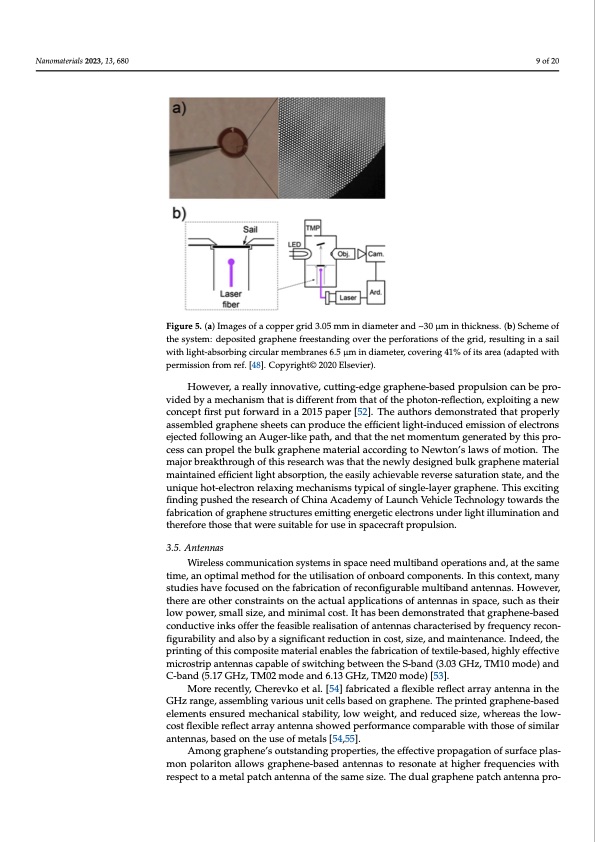
PDF Publication Title:
Text from PDF Page: 009
Nanomaterials 2023, 13, 680 9 of 20 Figure 5. (a) Images of a copper grid 3.05 mm in diameter and ~30 μm in thickness. (b) Scheme of the system: deposited graphene freestanding over the perforations of the grid, resulting in a sail with light-absorbing circular membranes 6.5 μm in diameter, covering 41% of its area (adapted with permission from ref. [48]. Copyright© 2020 Elsevier). However, a really innovative, cutting-edge graphene-based propulsion can be pro- vided by a mechanism that is different from that of the photon-reflection, exploiting a new concept first put forward in a 2015 paper [52]. The authors demonstrated that properly assembled graphene sheets can produce the efficient light-induced emission of electrons ejected following an Auger-like path, and that the net momentum generated by this pro- cess can propel the bulk graphene material according to Newton’s laws of motion. The major breakthrough of this research was that the newly designed bulk graphene material maintained efficient light absorption, the easily achievable reverse saturation state, and the unique hot-electron relaxing mechanisms typical of single-layer graphene. This exciting finding pushed the research of China Academy of Launch Vehicle Technology towards the fabrication of graphene structures emitting energetic electrons under light illumination and therefore those that were suitable for use in spacecraft propulsion. 3.5. Antennas Wireless communication systems in space need multiband operations and, at the same time, an optimal method for the utilisation of onboard components. In this context, many studies have focused on the fabrication of reconfigurable multiband antennas. However, there are other constraints on the actual applications of antennas in space, such as their low power, small size, and minimal cost. It has been demonstrated that graphene-based conductive inks offer the feasible realisation of antennas characterised by frequency recon- figurability and also by a significant reduction in cost, size, and maintenance. Indeed, the printing of this composite material enables the fabrication of textile-based, highly effective microstrip antennas capable of switching between the S-band (3.03 GHz, TM10 mode) and C-band (5.17 GHz, TM02 mode and 6.13 GHz, TM20 mode) [53]. More recently, Cherevko et al. [54] fabricated a flexible reflect array antenna in the GHz range, assembling various unit cells based on graphene. The printed graphene-based elements ensured mechanical stability, low weight, and reduced size, whereas the low- cost flexible reflect array antenna showed performance comparable with those of similar antennas, based on the use of metals [54,55]. Among graphene’s outstanding properties, the effective propagation of surface plas- mon polariton allows graphene-based antennas to resonate at higher frequencies with respect to a metal patch antenna of the same size. The dual graphene patch antenna pro-PDF Image | Role of Graphene in Space Technology

PDF Search Title:
Role of Graphene in Space TechnologyOriginal File Name Searched:
nanomaterials-13-00680-v2.pdfDIY PDF Search: Google It | Yahoo | Bing
Salgenx Redox Flow Battery Technology: Power up your energy storage game with Salgenx Salt Water Battery. With its advanced technology, the flow battery provides reliable, scalable, and sustainable energy storage for utility-scale projects. Upgrade to a Salgenx flow battery today and take control of your energy future.
| CONTACT TEL: 608-238-6001 Email: greg@infinityturbine.com | RSS | AMP |